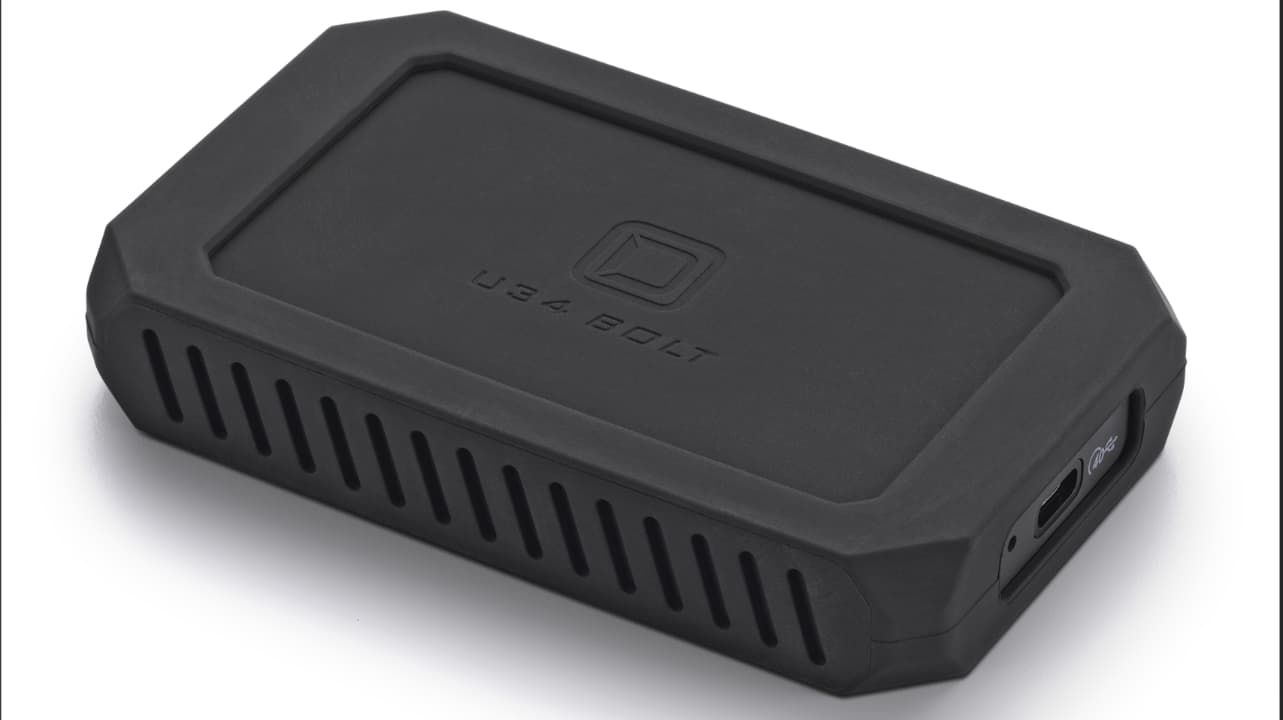
The speed, security, and performance of the Oyen Digital U34 Bolt convinces Ned Soltz that the move from primary reliance on HDDs to solid state storage is one whose time has come.
I am still reeling from the great crash of November, 2019. No, not the stock market but rather a serious of cascading computer failures. An unknown glitch still never identified froze my MacPro (a 2017 purchase since replaced with the MacPro 2019) which in turn scrambled my 4-drive 32TB G Speed Studio RAID configured as RAID 5. And the failure cascaded to a single spinning bare hard drive in an OWC drive dock being used at the time to back up some older footage in preparation to archive some projects going back 10 years or more.
RAID 5 would allow the failure of one drive and subsequent rebuilding of the RAID. But in this case, multiple drives were scrambled and nothing either I nor G-Tech could do would recover the data short of very expensive file recovery services which still could not guarantee data retrieval. And the backup drive scrambled as well beyond recovery. My only choice was to rebuild the RAID and restore from spinning drives that contained more current projects. Some valuable original footage was lost. The subsequent replacement of the machine with a 2019 MacPro along with the rebuilding of the RAID has been trouble-free for the past 5 years.
But it’s time to rethink not just Intel-based Macs but also spinning drive storage. The G-Tech RAID has lasted well beyond its plausible life span. It is a Thunderbolt 2 device connected to the Thunderbolt 3 2019 MacPro with an adapter cable. This system is still at OS 13.6 because G-Tech, now acquired by Western Digital, cannot guarantee support of this TB2>TB3 adapted storage to current MacOS. And it is slow.

It's lasted a long time, but the G-Tech drive is slowing down...
While most of my work the past 4 years has moved to still photography with less video, I nonetheless only shoot 4K video with a smattering of 8K just for reframing purposes. And I still back up from the RAID to bare hard drives in the same dependable OWC drive dock.
I made a move to Apple silicon with the original 2021 M1 MacBook Pro 16” laptop and it significantly outperforms the 2019 MacPro Intel.
But now, for the point of this whole shaggy dog story: it is time to consider moving to solid state storage.
More speed and a longer life
The latest generation of NVME devices paired with fast Thunderbolt 4 interfaces exponentially increases transfer speeds not to mention read/write speeds. While any media is subject to failure, NVME drives have to potential of lasting up to 10 years while most authorities consider the lifespan of conventional HDDs to be 3 to 5 years or perhaps longer with enterprise-quality drives. Because reliable back up is essential, I personally focus less on drive longevity than on convenience and speed.
Oyen Digital, a Minnesota-based storage vendor, sent me its U34 bolt 8TB external pocket NVME drive. I copied about 4.5TB of current working files from the G-Tech RAID to the U34 bolt. This included about 80,000 RAW images in my Lightroom catalog. Needless to say, it was a multiple hour process plus another hour or so to relink the Lightroom images to the catalog copied to the U34 Bolt.
Oyen Digital has been around since 2005 and produces a line of portable, desktop and RAID enclosures with an emphasis on quality components, customer support and understanding the needs of professionals. The U34 Bolt portable storage device comes in 2TB, 4TB and 8TB capacities. It measures a mere 4.5”x2.5” and is only ¾” thick and weights 8oz. It has a single Thunderbolt 4 USB-C interface, backwardly compatible to Thunderbolt 3 as well as USB-C compatibility and is provided with a Thunderbolt 4 rated cable. It is totally bus-powered. A visual of the drive sitting on the MacBook Pro keyboard gives you a perspective of its size.

It's a compact 4.5”x2.5” as you can see
Internally, it interfaces through an ASMedia ASM2464PD controller and has a Triple Level Cell NVME (also sold separately as a bare NVME). It touts Mac, Windows and Android compatibility.
The construction is solid. Externally, it has a silicon sleeve for drop protection as well as an internal layer of silicon. The core is aluminum and the external enclosure functions very effectively as a heat sink. In hours of initial transfer, the external case barely got warm to the touch. I have had it connected continuously to the MacPro system for a month and, once again, it is barely warm to the touch.
Real world performance
The drive came preformatted as Apple AFS+. My preference with current MacOS iterations is APFS so I reformatted the drive. It could also be formatted as ExFAT for cross-platform compatibility.
Note below the results of AJA Speed Test on both Thunderbolt 3 and Thunderbolt 4 machines. While obviously the Thunderbolt 4 machine delivered faster read/write speeds, even Thunderbolt 3 delivers fast transfer and sufficient throughput for seamless editing of 8K video. Needless to say, 8K playback was smoother on my M1 MacBook Pro than on the 2019 MacPro with dual Radeon cards. In fact, I was able to achieve 5 layers of 8K 30p HDR video at full resolution in an Adobe Premiere timeline with the MacBook Pro.

Speed on Thunderbolt 3

Speed on Thunderbolt 4
Of course moving to solid state storage requires some significant workflow considerations. A creator with whom I spoke told me he keeps multiple solid state drives and divides his projects among them. That represents a solution to the loss of multiple-terabyte RAID configurations. Yet it also involves an awkward backup strategy where he backs up these faster (and perhaps more dependable) SSDs to the slower and less-dependable spinning HDDs. But for his purposes and quantity of data as an individual producer, he finds the solution workable.
But to move to more practical considerations, the 8TB U34 devices retails for $1099 while the 2TB version is priced at $299 and the 4TB version at $429. The $1100 price point for 8TB compares favorably with the 8TB Prograde Drive ($1189) and the OWC Express ($1399). Oyen Digital sells the bare 8TB NVME for $899, so it is only an additional $200 for the enclosure and cable. While there seem to be price drops on the smaller-capacity drives, the 8TB mechanisms are priced higher per TB. A fair guideline is to maintain 25% or so free space on a working drive so realistically at least 6TB of working data could fit on the drive. I currently have about 5TB stored on the drive.
Conclusion: The solid state future
While price remains a practical consideration, this capacity may very well prove to be adequate for current working projects of a vast percentage of creators. This is not taking into consideration cloud storage which now emerges more and more as both stand alone and hybrid local-cloud storage, editing and collaboration media storage. One might also consider scalable NAS solutions such as QNAP as redundant backup or longer term storage schemes.
For me and I dare say for a significant percentage of individual creators, fast portable storage on the 8TB U34 Bolt with backups to HDDs or offloading no longer current projects to other media represents the best solution to fast, efficient and reliable working media storage. A move to SSDs thus requires a complete plan for current work, intermediate and long term storage and backup. My conclusion is that the value that SSD storage brings to the game is well worth any shifts in strategy.
Meanwhile, I can enthusiastically recommend the Oyen Digital U34 Bolt 8TB and would work under the assumption that the 2TB and 4TB versions would be equally superlative. It removes the anxiety from me of aging spinning disk RAID which already caused grief 5 years ago as well as potential compatibility issues of the RAID. It is compact and portable with fast read/write speeds. It is backed by a user-centric company that is not too big to lose sight of its customers. The speed of the device and the sense of security of my data convince me that for my purposes and the purposes of many creators, the move from primary reliance on HDDs to solid state storage is a time that has come. And the Oyen Digital U34 Bolt is a device which can be a cornerstone for that move.
tl;dr
- The Oyen Digital U34 Bolt's speed and performance indicate the shift from HDDs to solid-state storage is necessary for modern workflows, especially after experiencing significant data loss from hardware failures.
- Oyen Digital’s U34 Bolt offers impressive build quality, compact design, and fast transfer speeds via Thunderbolt connectivity, making it a reliable choice for professionals.
- Transferring approximately 4.5TB of data, including 80,000 RAW images, highlighted the efficiency of the U34 Bolt, facilitating smoother data handling and organization.
- The drive supports various formats (APFS, ExFAT) and devices (Mac, Windows, Android), ensuring flexibility and adaptability for diverse user needs.
Tags: Post & VFX Storage Oyen


Comments